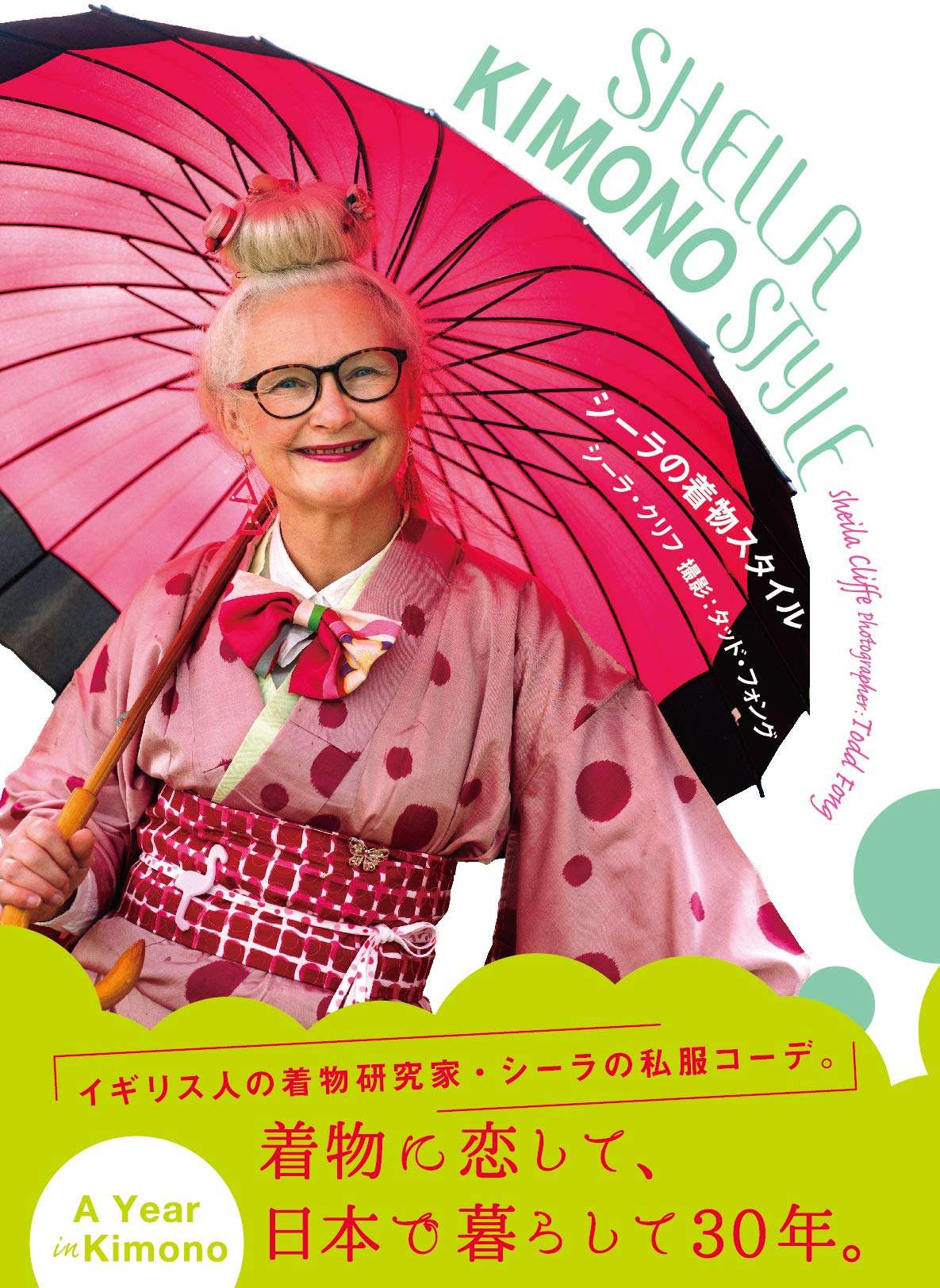
イギリス人着物研究家、シーラ・クリフさんのインタビューを全2回でお届けします。後編では、着物のトレンドや技術革新、着物を着たいけど一歩踏み出せない人へのアドバイスをお伺いします。英語音声も併せてお楽しみください。
※本記事は『ENGLISH JOURNAL』2022年9月号に掲載された内容を再編集したものです。
前編では、シーラさんの忘れられない着物との出合いや、なかなか語られない日本の服飾史などについてお伺いしました。
★前編記事入る
シーラ・クリフさんってどんな人?
シーラ・クリフさんは、イギリス出身の着物研究家です。日本で暮らして約35年になるクリフさんは、大学で英語と着物文化を教えながら、着物の魅力を国内外に広める活動をしています。また、おしゃれ且つ個性的な着物の着こなしでSNSでのフォロワーも多く、着物インフルエンサーとしてテレビ番組やCM、雑誌などでも活動しています。その数々のすてきな着こなしは、ぜひシーラさんのInstagramでご覧ください。
着物の新たなトレンドと革新
――最近(2022年4月)の着物のトレンドは、どのようなものですか?
模様のトレンドの一つに、ネコの柄がすごくはやっています。なぜかは分かりませんが、着物を着ている女性にはネコ好きも多いんです。ですからネコの柄の着物が多いのです。以前はイヌや獅子のような柄が多かったのですが、最近ではネコが人気です。
また、絹のように見えるポリエステルの一種で「セオアルファ」という新しい布地を使った着物も多くて、絹と比べるとかなり価格が抑えられます。綿やポリエステルなどの洗える着物も人気です。新しい技術であるデジタルプリントは、市場を変えていると言えるでしょう。手作業ではできないような、鮮明な画像を布地に印刷できます。
例えば丹後地方の織物業者は、常に新しくて面白い着物や帯の織り方を開発しています。ヘビ革などの動物の皮のような柄を織るなど、新しい工夫をしています。機械の歯車の柄とかね。それらが金糸で織られたものを見たことがあるんですが、本当に見た目がすてきなんです。着物の世界ではたくさんの新しい技術が生まれていて、とてもわくわくします。
市場について言うと、着物市場は本当に変わってきていると感じます。何しろ数年前、例えば私が初めて日本に来た1985年は、結婚式に出る人、茶道や生け花の席に行く人しか着物を着ているのを見掛けませんでした。着物が好きだからというより、社会的な催し物のために着ていたんですね。今はそういう催し物がかなり少なくなったものの、みんなが着物を着たいから着るようになっています。好きだから着ているのです。私が教員になったばかりの頃は、卒業式ではみんなスーツを着ていましたが、今はみんな着物を着ているのも興味深いですね。つまり、着物文化が戻って来ているんです。確実に盛り返して来ていますね。
とにかく着てみることが大切
――着物は着心地が悪いし、正しく着るのが面倒だと思う人も多いです。そのような考えを持っている人に、どんな言葉を掛けますか?
着物の着付けは技術です。ですから、誰でも上手になる前は下手なのが当たり前です。スポーツを習ったり裁縫を習ったり、その他いろんなものと同じように。始めたときは、みんな下手です。下手に着てもいいんです。下手な着方をしたからといって、誰にもそれをとがめる権利はないのです。街中で洋服を着ている人に近づいていって、「ねえ、そのセーターの着方はひどいわよ」とか、「ジーンズのこんなにひどい着こなしは見たことがないわ」など言うとしたら、それはとても無礼なことです。でもどういう訳か日本には、他人の和装を批判してもいいと思っている年配の女性がいるんです。そんなの駄目ですよ。
誰でも最初は着るのが下手で当たり前です。ですから、着るのが下手でもいいから、挑戦してください。着てみてください。たくさん着るしか上達の道はないのですから。それでいいんです。みんなが着物のファッショニスタになるわけじゃないのですから。洋服のファッショニスタが数人しかいないのと同じです。ですから、ただ着ればいいんです、とにかく着てみてください。
そしてもう一つのアドバイスは、初心者の方は、最初は洋服の上に着物を着てみるということです。着物の下着の長じゅばんは着ないで、着物1枚をジーンズとハイネックのシャツや襟付きのシャツ、あるいはTシャツの上に重ねて着るんです。というのも、まず覚えなければならないのは、着物を留めるための腰ひもを結ぶことなので。
私が子供の頃は、みんな自分の靴ひもを結んでいました。でも今の日本の子供たちの靴には面ファスナーが付いているので、子供たちはひもを結ぶことを習いません。このひもをしっかり結ぶことが、着物を着るための最初の鍵なんです。この腰ひもをしっかり腰で結ばないと、着物がずり落ちてしまいます。ですから、まずは長じゅばんは忘れて、着物を着る練習をしてください。もう1本のひもを胸の下で結んで、着物の襟を好きな位置で平らに押さえ付けます。この2本のひもを結ぶことができれば、基本的には着物を着ることができます。
インタビュー音声と英語スクリプト
実際のインタビュー音声を聞いてみましょう。シーラさんの話す英語は、イギリス英語。語尾のtやdの音の強調が目立つのが特徴です。ゆっくりでとても丁寧な話し方なので、聞き取りやすいでしょう。英語スクリプトもご参考ください。
――You said kimono are still evolving. What are the kimono trends now?
One trend — it’s just a pattern — but one trend is that designs of cats are really popular. I don’t know why, but lots of kimonowearing ladies are also cat fans, and so you get lots of kimono with cat designs. (It) Used to be more like dogs or “shishi”, like lion kind of designs, but recently cats are popular. And there are lots of kimono using new textiles like CEOα, which is a kind of silky-like polyester, which brings the price down a lot from silk. Washable kimono are popular — so cottons, polyesters and that kind of thing. Digital print is a new kind of technique that is also changing the market — so kind of photographic images which you put on textiles that couldn’t be done by hand. Those are changing the market as well.
Weavers in the, for example, Tango area are always making new and interesting weaves, which can be used for woven kimono or obi. And there have been, like, innovations such as weaving in patterns influenced by animal skins or, like, snakeskin or something like that. Or cogs in a machine. I’ve seen those woven in gold thread, and it’s really cool looking. So, there is a lot of innovation going on in the kimono world. It’s very exciting.
And I really think the market is changing. I mean, a few years ago — when I first came to Japan, for example, 1985 — you only saw people going to weddings and people going to tea ceremony and ikebana. So, they were wearing it for a social function rather than because they liked kimono. But now those social functions are so few, but people are wearing it because they want to wear it. They’re wearing it because they like it. And also, another thing that’s interesting is that when I first started teaching, everybody wore suits for graduation ceremony, but now everyone wears kimono. So, there are ways that kimono is coming back. Definitely coming back.
――There’s a common conception that kimono are too uncomfortable to wear and too much trouble to put on correctly. What would you say to people who think that way?
Kimono dressing is a skill. And so, everybody has to be bad at it before they’re good at it. Just like you’re learning a sport or learning to sew or any other thing. When you start, you’re bad. And wearing it badly is OK. And no one has any right to tell you off for wearing it badly. If you walked up in the street to someone in Western dress and s— said, “Hey, you’re wearing that sweater so badly,” or, “I’ve never seen anyone look so awful in jeans,” that would be so rude! But for some reason, there are some older women in Japan who think it’s OK to criticise other people’s kimono dress. It’s not OK.
And everybody has to wear it badly first. So, even if you wear it badly, go ahead. Wear it. The only way to get better is to wear it a lot. And it’s OK. Not everyone is gonna be a super fashionista in kimono. Just like there are only a few people who are super fashionista in Western dress. So, just wear it, go ahead and do it.
And my other piece of advice is, for beginners, when you start, wear it on top of Western clothes, just no “nagajuban” underwear, just the kimono, one layer on top of jeans and a high-neck shirt or a shirt with a collar, or even a T-shirt. Because the first thing that you have to learn to do is tie the “koshihimo” that holds the kimono up.
When I was a kid, everybody tied their shoelaces. But in Japan now, all kids’ shoes have magic tape, so kids don’t learn to tie. And tying this tightly is the first key to wearing kimono. Because if you don’t tie this tie at the waist tightly, then the kimono will slide down. So first, just forget the nagajuban and practice tying on the kimono. And you put one more tie under the bust to hold the kimono collar flat where you want it. If you can tie those two ties, basically you can wear the kimono.
数々の着こなしはスタイルブックで!
取材:知夏七未 写真:安宅雅美(編集部)









